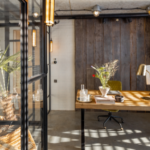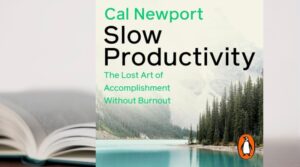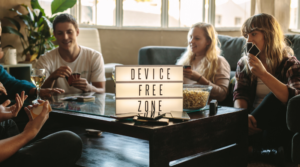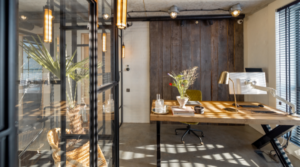
I know it’s bad, but…
Pre-March 2020, digital innovations facilitated escalating levels of performance expectations, pressures, work pace and stress, the majority of knowledge workers operated within well-established business norms.
Despite these norms and expectations having shifted significantly over the previous two decades, the rate of change had been slow enough to develop sufficient coping mechanisms for many to adapt to a relatively healthy-ish way of working.
Then in March 2020, the majority of knowledge workers were forced to dramatically recalibrate the process of ‘doing work’.
Since then, a more remote and hybrid way of working has been how a lot of us manage our day-to-day working lives.
There are, however, both positive and negative psychological, emotional, physical and behavioural consequences to this (dare I say it?) ‘New Normal’.
The pace of future digital innovation that facilitates on-site, remote and hybrid work will continue to shift work practices, biases, norms and expectations.
This is bound to naturally exacerbate increased ‘work creep’ into the home space. This engagement with work-based activities and ruminating, alongside engaging in electronic communication, beyond the paid working day both encroaches on and disrupts personal time.
When this does happen, you will often hear workers use the phrase ‘I know it’s bad, but…’ – and then launch into a confession of how and when they use their workplace technology after working hours, even though they are conscious that it’s not good for them.
This work creep will decrease a worker’s ability to allocate sufficient time to emotionally, mentally and physically recover from work – leading to lower levels of productivity at the office, less time for family and personal pursuits and greater levels of stress, anxiety and burnout amongst office workers.
This project is ultimately about how we manage the digital boundaries between our work and home lives, and what drives us to allow more of our personal time engaging in work-based tasks and communication.
It is also about how we can take back control of those boundaries between work and home to define and create one that is unique to us – allowing us to be more present at home, productive at work and enjoy more time at play.
The project work is be based on the ‘Boundary Blurring Model’ (below) developed by the team at Cybercology.
The research on this area of psychology and the human-computer interface, seems to indicate that those who actively manage their boundaries between work and home are less likely to experience elevated levels of stress and anxiety.
However, only 1 in 3 workers actively have a boundary management strategy in place – having a good ‘balance’ between work, life and play.
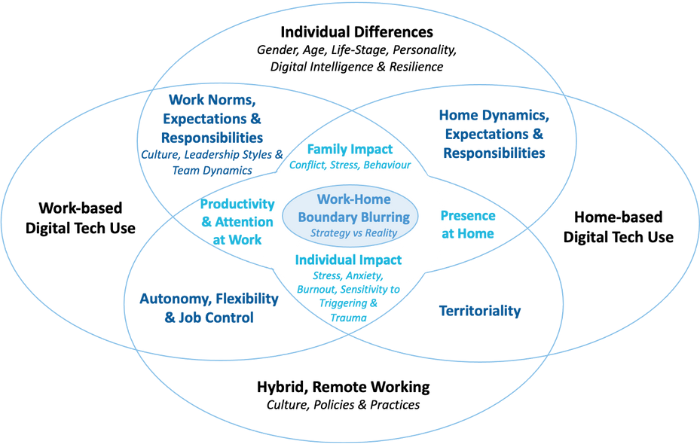
Several variables feed into how we use technology for work, home and play. These factors then feed into and influence each other on a regular and consistent basis. Every individual is in a completely unique work and home situation, with different roles, responsibilities and needs.
Even research in the area of technology use at work and home is disparate across various disciplines and industries – including, but not limited to: organisational, neuro and social psychology, computer sciences, human-computer interactions and business studies.
So, although it is difficult to prescribe specific common denominators for everyone, the aim is to address a number of interlinking themes and variables that affect most of us and provide some insight into how the use of digital technology is shaping the modern work and home life in general, and the psychological impact of digital technology use on us as individuals and families in particular.
You may notice that Work-Home Boundary Blurring is at the centre of this model – and there is a reason for this. When it comes to juggling and managing work and home life, what seems to come up as one of the king-pin facilitators of stress, anxiety and burnout is how we use work-based digital technology to blur the boundaries between our home and work life and responsibilities. All the surrounding factors either influence or are influenced by how much we blur the boundaries we create for ourselves between work, home and play.
Because of how we use technology to communicate with others, the very nature of this use facilitates these boundary-blurring activities. How we manage the use of technology in creating or blurring these boundaries, therefore, can directly impact our levels of stress, anxiety and potential burnout.
Each of these areas will be covered within this project (see sections below) and give you some food for thought on how you use your personal and work-based technology to facilitate your life activities, and how you may take back some control of that digital technology use, in a way that fits in with your individual commitments, responsibilities, dreams, desires, life goals and ambitions.
The interlinking of these phenomena, although in no way complete, showcases the complicatedness of factors that impact on our overuse of workplace digital technology use during our private time. No one factor can be seen in isolation of the others.
It is potentially impossible to generalise completely and may be psychologically tricky to do so. But there is some attempt to provide academically based insights that may start conversations, challenge conventional wisdom, shift biases and empower individuals, teams, managers and owners to better understand themselves and those around them. This is the hope.

The aim is to help you understand what areas most affect you and help you with setting out your own work-home boundary management strategy – balancing all your work and home responsibilities in a more effective way. It is about helping you develop a bespoke strategy, identify areas you are willing to temporarily allow ‘boundary violations’ and how to manage a healthier, and more in-control relationship with gadgets and digital technology.
The content from the project will (in the longer term) form the basis for a book, workshop, more talks and therapy practice – which will hopefully be helpful for you in the process of uncovering your own technology use impact.
Worldview and underpinning
Taking into account how and why we use our technology (i.e. compulsively or purposefully), there are two opposing perspectives on whether or not digital technology plays an active or passive role in our lives.
The socio-constructivist view, where technology is a neutral tool and plays a passive role in our lives. The argument is that it is just a machine and has no ability to actively determine how we use it. It has no personality and no agency. It is useful only in how the gadgets and devices improve how we operate. This view focuses on the dynamic interactions between people and technology and how this use is constructed by us as individuals and as a society.
And then there is the deterministic perspective. According to this view, technology is a little more sinister. It has the agency and ability to change and shape our behaviour and how we interact with our devices and gadgets. It plays an active role in influencing our behaviour, to the extent that we are almost controlled by (rather than controlling) them and subject to its whims. Examples given in this debate is how social media’s AI algorithms draw you in and make it difficult to put the phone down. They play an active role in creating addictive habits and creating our own echo chamber.
We can compare digital technology to any other forms of innovation – a motor car, a ballpoint pen, a light bulb…
Each of these have potential positive and negative impacts on our individual lives and on society – depending on how they are fashioned and for what purpose they are created and used.
All adopted technology changes the way we live and how we perceive and engage with both ourselves and others around us.
The concepts presented throughout this project are approached from the social constructivist view of technology.
Technology is developed and used by society for an end point. We have agency over our gadgets and devices, and we use them for our societal and personal purposes to benefit and improve our lives
Simultaneously, although we take the perspective that technological tools are in and of themselves neutral. Using them changes us – both individually and collectively.

So, although technological devices are in and of themselves neutral, the very use of them, paradoxically, makes them a catalyst and accessory to our personal, societal and cultural transformation.
Their use changes how we act and interact, how we think and feel, how we view and engage with ourselves and the world around us, how we live and how we work.
It is possible that our relationship with our gadgets and digital tech is a combination of:
- how we learn to use our devices in our lives
- how we view and copy the behaviour of others interacting with their gadgets
- the behavioural and communication expectations we perceive as normal at work and at home, and
- how tech and apps are deliberately constructed by their makers in order to increase our use to maximise their business model and satisfy their shareholders.
What we can be certain of is this, like our fingerprints, how, when, where and on what device we use our work-based tech, software and apps to fulfil our role is unique to every one of us.
Project aim
In essence, this project is an exploration of:
- how mobile digital technology and gadgets have changed, are changing, and will change what it means for knowledge workers to ‘do work’,
- how the nature of the work has changed with the use of digital technology and,
- how this has impacted the individual and their work, home and play in the twenty-first century.
It also:
- investigates how the expectations and norms of work have evolved over the first two decades,
- highlights the lessons we learnt from the dramatic pivotal shift at the beginning of the third decade,
- explores how work may seismically shift again while we head into the next few decades,
- provide professionals with the insights and tools they need to be able to recognise and manage the impact digital technology has had on their behavioural, psychological and social aspects of their lives and how to develop bespoke digital strategies that developed a more balanced relationship with digital technology and make the changes needed have to a more positive, present way of being.
This work is underpinned by academic research, but it is not an academic or historical documentation that simply presents facts and figures.
Rather it is a ‘so what?’ and a ‘now what?’ for us as individuals and as a society within this ever-expanding knowledge economy.
It is also a practical guide for us, as unique individuals, to be able to make more informed decisions when it comes to how, and when, we engage with digital technology and gadgets in our daily lives – especially when work is infringing on our personal space and time.
There are many hints, tips and tools throughout that can be tried and individually tweaked to help you manage your tech use and create your healthy work-home-play boundaries.
We are all so unique in our work and life circumstances, so no one-size-solution fits everyone.
The aim is to make all the practical elements of the project as useful as possible – understanding that, in doing so, not everyone will find everything useful.
We are all in a constant transition of learning new ways to optimise the digital technology that we use to engage with others and manage our daily activities, time and attention.
It is more of a struggle for some than for others, but we all do struggle to find the right balance – especially as it seems both life and technology is constantly advancing at such a radical pace.
Ideally, we each need to develop, as individuals, teams and companies, our unique boundary management plan and strategy, that maximises productivity at work and increases quality time at home and play, to steer us to where we want to be.
Because, without a definitive strategy to guide us, we can become more and more entrenched in habits that take us away from the things we most value.
And stress, anxiety and burnout come when we fail to set a plan and (mostly) stick to our personal boundaries around work, home and play.
This work is therefore not an endpoint, but rather the beginning of the discussion around how we, as working adults, continue to develop and build a healthier relationship with the digital technology we use – both in how we shape our tools and how our tools then shape us.
How to navigate this work
To gain a context of later sections, it would possibly be of greater benefit to read this work from start to finish.
But, you can still gain plenty of insights if you choose to jump around and read sections that you are more interesting to you. To help you navigate, this is what is contained in each of the parts.
Please Note!
This project is a work in progress, so not all sections are currently at a publishable stage. Please be patient while we build these sections.
Part One
Technology's Trojan Horse
This section forms the background to the psychology of technology use for communication and tasks in a work context.
In this section, we will unravel:
- how we have let the ‘work-tech-enemy’ into our home fortress,
- how we fully embrace new technology without taking stock of the life consequences,
- what factors have led to our elevated stress levels and working much longer hours than we think is good for us.
We will cover:
- Work-home boundary blurring: What it means and how we separate or integrate our work and home lives
- Hybrid and remote working culture, policies and practices: Why they matter and how they impact us.
- Territoriality: We used to personalise our desk space at work to make it a little more ‘home away from home’. Now with hot-desking and hybrid working, we’re creating space in our homes to make the space in our homes ‘work away from work’. We explore how we’re giving up part of our ‘home geography’ to workplace activities – and what this means for our digital mental health.
- Work and home technology: How we juggle and merge the use of our tech, gadgets and digital communication – so it becomes more difficult to differentiate/tell where one ends and the other begins.
Part Two
The Stories We Tell Ourselves and Other Tales
Drilling down into our relationship with our digital technology and how it affects our work and home life. We will explore how workplace narratives, and how we talk about our work, influence our behavioural norms and gadget use – in particular:
- the psychology behind our digital habits
- how our perceptions, biases and habits drive our decision-making process and habit formation around work during our private time
- how we respond to the workplace conversations we hear around us,
- how the things we say and hear (narrative psychology) influence what we do and how we view the world we live in i.e. the psychology behind our digital tech use,
- how we talk ourselves in and out of digital habits at work and home,
- how the demands of others in our households affect our ability to focus and manage our time efficiently
- how that translates into family dynamics and work-based availability expectations,
- the paradox of flexibility, autonomy, and job control and the importance of finding the right habits and processes that increase work productivity and improve presence at home.
We will cover:
- Work norms, expectations and responsibilities: How perceptions, biases and habits drive our decision-making process and gadget use, and how we layer our work and home technologies in unhealthy ways that mitigate a good work, home, and play balance.
- Home dynamics, expectations and responsibilities: How many demands of energy, focus and time are required by others in the household and how do others in the house manage levels of workplace confidentiality?
- Autonomy, flexibility, and job control: It’s not as good as it first seems and has consequences that we need to re-align to optimise productivity and presence.
Part Three
Managing the Fox in the Hen House
This section is about learning to have a better relationship with technology. We’ll talk about making good choices with our workplace technology use and gaining back control of when and where we use that technology. We will:
- explore how we can build a better relationship with our gadgets and digital technology,
- dive into how we manage the impact of our tech-based decisions, so we can develop personal strategies and tactics to help take ownership of gadget use by setting healthy, realistic boundaries to protect and restore mental, cognitive and emotional energy levels,
- cover how we manage the impact of our tech-based decisions and,
- hints and tips on how to develop strategies and tactics that help us to take ownership of gadget use and control how we use our digital communication tech, and set healthy, realistic boundaries that protect and restore mental, cognitive and emotional energy levels.
We will cover:
- Individual differences and subsequent impact: How your unique personality traits, work habits, make-up, homelife, life circumstances, life preferences and worldview impact your workplace gadget use during your leisure time – and the consequences thereof on your physical, mental and emotional wellness, and the ability to recover sufficient energy levels each day.
- Presence at home and family impact: How our tech behaviour impacts our ability to be fully present, how it changes our cognitive thinking, and how it emotionally and behaviourally affects our family life, including the relationship with our partners, the way our children work and think – and hints and tips on what we can do about it.
- Productivity, attention and cognitive thinking impact on work: How tech use has hijacked our sleep, attention, focus and productivity levels. This highlights the importance of getting back control and finding the right balance between flexibility, autonomy and job control to increase productivity and cognitive presence at work.




